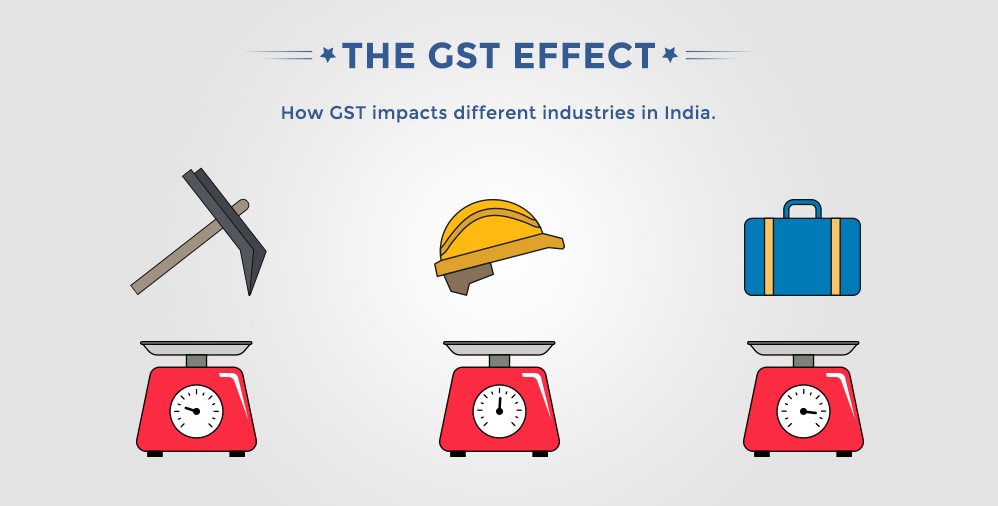The Indian government will be introducing a Goods and Services Tax (GST) that can tackle the inconsistencies across the belt of indirect taxes, make tax across transactions more trackable, and consequently less ’taxing’ for both the seller and the buyer. In this article, we are going to take a look at how GST will impact and disrupt different industries from agriculture to e-commerce to air travel.

Agriculture
In this section, we are going to talk about the industries that directly impact everyone.
Agriculture has always been the root of the Indian economy. With that in mind, the government has been exempting many food items such as meat, eggs, coarse grains, fruits, and vegetables from the CENVAT (Central VAT), even though cereals and food grains are associated with a state VAT (Value Added Tax) of 4 percent.
This is going to change with the implementation of GST as all the indirect taxes associated with agriculture will be merged together and streamlined across all Indian states. We are bound to see an increased tax base (more products will now become taxable), and this increase (along with an increase in the tax rate from 4% to 12-18%) will contribute to a rise in the prices of agricultural products and services. That being said, the products will be able to reach places by road faster than today owing to less paperwork and less time spent at toll gates.
Fast Moving Consumer Goods
Next up, we have the Fast Moving Consumer Goods (FMCG) industry that includes food, beverages, household and personal care items. These are currently liable to a total tax of >26% (this is the result of a 12.5% excise and a VAT of 12 to 14.5% on top of excise). This excludes most of the agricultural processed products that either enjoy a VAT exemption, or are liable to a lower bracket of taxation (4-5% of the value). With GST at a rate of 12-18%, we will see a drop in the prices of most FMCGs while it will have an inverse effect on prices of food products.
More than pricing, the greatest impact of GST on FMCG companies would be on their product distribution and warehousing. As of today, the distribution costs for FMCGs account for up to 7% of business turnover, and to keep it as low as possible, they establish warehouses in every state where they operate (this is done in-order to avoid Central Sales Tax, or CST, on interstate sales). Based on demand, the goods are transferred among warehouses and sold to distributors locally.
Under the GST, local and interstate supply would be tax neutral and India would be treated as a single common market. This shift would allow companies to reconsider the location of warehouses from a tax saving stand point to a market centric one that offers more savings and faster deliveries.
Manufacturing
In this section, we will focus more on the secondary sector of the economy, i.e., manufacturing.
The manufacturing sector encompasses a wide range of industries. Currently, this sector is subjected to an array of taxes such as the excise duty, VAT, CST, etc which are levied at each level and are added to the whole value of the product (this is known as tax cascading). One of the biggest challenges of this sector is to try and reduce the cost of production while delivering the maximum value to end customers. The new GST regime will make it more easier on this sector by contributing to a lower cost of production as tax at each level will be charged only on the value added to an item (Read more about the basics of GST ). One of the major defects of the current indirect tax regime – the absence of tax credit for central/union taxes over state taxes and vice versa – could be eliminated by allowing unrestrictive tax credit under GST.
Another major challenge faced by the manufacturing sector today is transferring goods from one state to another while also acquiring raw materials from another state. This is because the state-border checkpoints that ensure material scrutiny and location-based tax compliance take up roughly 60% of a truck’s transit time. These unproductive transit hours coupled with regulatory impediments reduce the efficiency of Indian manufacturers as compared to their international counterparts.
The new GST regime will once again better the situation by unifying the Indian market and facilitating a smoother flow of goods within the country. Although border checkpoints may still exist for some time, the lesser scrutiny at these checkpoints will greatly reduce transport hassles.
E-commerce & Supply Chain Logistics
In the section, we are going to focus upon certain aspects of GST that will restructure our supply chain logistics. According to the Constitution (122nd Amendment) Bill that advocates the GST regime, when we talk about supply, it does not differentiate between “supply to oneself” and “supply from one person to another”. This means that both the act of selling goods as well as transferring goods from one state to another will be treated in the same way. Though we cannot say for sure, if this was enforced, it will warrant a redrawing of warehouse strategy in-order to optimise organisational profits (you won’t be needing too many warehouses anymore). This will transform warehouses into fulfilment centres instead of distribution centres.
Further to this, the GST has two major benefits:
- Because of the availability of input tax credit on inter-state sales, you are now exempt from any form of tax cascading.
- With no CST or octroi on top of sales taxes in the picture, you no longer have to maintain extra warehouse steps in your supply chain.
This means lower distribution and holding costs, less bureaucratic red tape, and an increased ability to focus on your market. That being said, the additional 1% tax, envisaged as a replacement for Central Sales Tax, may not be available for credit, which will add to the cost of products.
We saw the impact of GST on our supply chain logistics; now let’s see how it also affects our e-commerce industry. With no tax laws currently in place for this industry, taxes are imposed by state governments based on their outdated and non-uniform tax laws. The GST aims to correct that, by increasing it’s tax base and levying a uniform tax rate for goods and services all over India. This will result in fewer regulations, lesser paperwork and consequentively consistent item prices and faster product shipments and returns.
Services
- As the name says, the GST will also make a huge impact on our tertiary sector. To understand it better, we are going to take a look into 5 service based industries that impact our daily lives.
Technology
- On the plus side, GST will eliminate multiple tax levies and allow for deeper penetration of digital services. At the same time, it will be a disadvantage to IT companies that have several delivery centres and offices working together to service a single contract. This is because each centre is required to generate a separate invoice to every contracting party.
Telecommunication
- On the bright side, GST will bring down/streamline the prices of handsets across states owing to uniform taxation and lower production and distribution costs. On the other hand, call charges and internet data rates will go up if GST ends up exceeding 15%.
Media & Entertainment
- Things are looking bright for DTH providers (Direct to Home dish tv providers), film producers and multiplex players who are currently liable to a non-uniform entertainment tax on top of regular service taxes. This is because the GST regime will bring down the tax levied on their services by 2-4%.
- Additionally the GST will also offer input credits on all taxes levied under this regime; that means more revenue gained for these service providers and a possible reduction in the prices of their services. (Bottom line - You will be able to watch more movies per month in theatres. ;) )
Insurance
- Life, health and motor coverage will become more expensive from July 2017 as taxes will go up by 3%.
Air Travel
- Air travel in India will become far more expensive, as the current service tax of 6-9% will be replaced by a GST of 15-18%. (It’s better to buy a tourer and travel by road than travel by air as automobiles will be cheaper with GST ;) )
Conclusion:
The Indian market is no longer what it was a decade ago. Hence our tax laws must also keep up with the changes that occur to the market if they are not meant to be bottlenecks to the growth of our economy. With that in mind, the Goods and Service Tax is an attempt by our government to simplify and streamline our taxes, facilitate market growth and increase the revenue for our government by increasing its tax base.
Though the introduction of GST will initially increase the prices of our essentials such as agricultural products, certain FMCGs like processed food, electronics, insurance, etc, it will bring down the burden of taxes borne by the end consumer. This is because tax cascading and unwanted scrutiny at toll checkpoints will be eliminated which in turn will help industries invest more time and resources on sales rather than on tax handling.
On the flip side, the current area-based exemptions will become irrelevant, making services more expensive. (No more special economic zones.)

